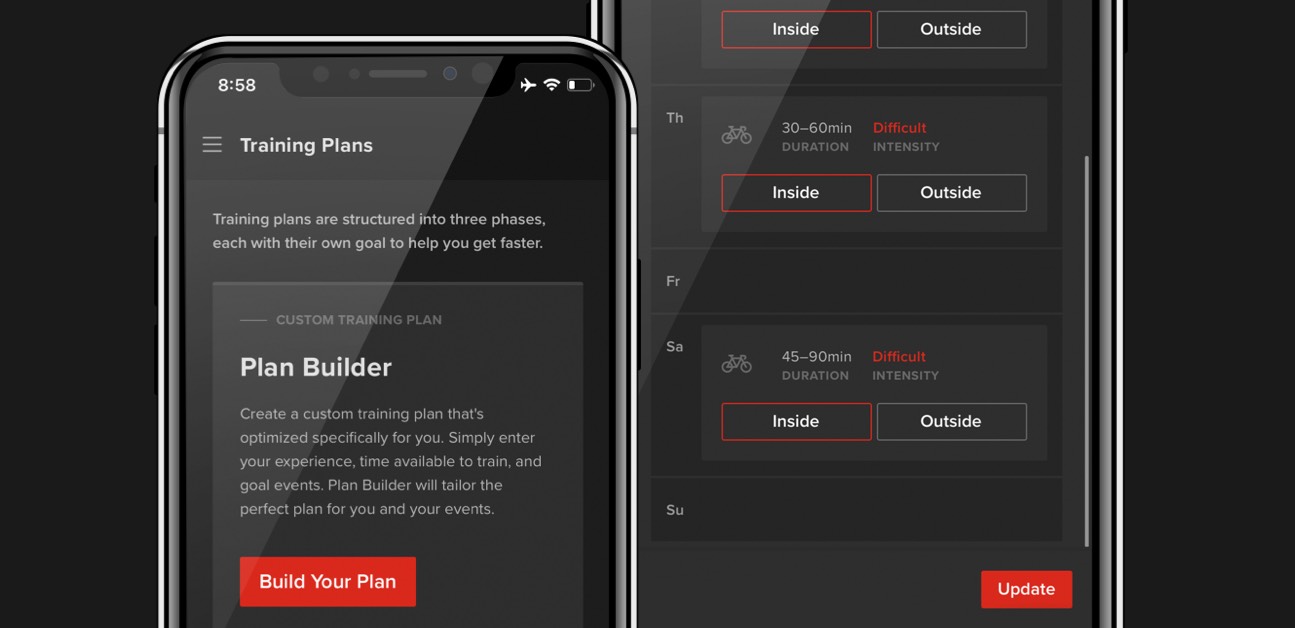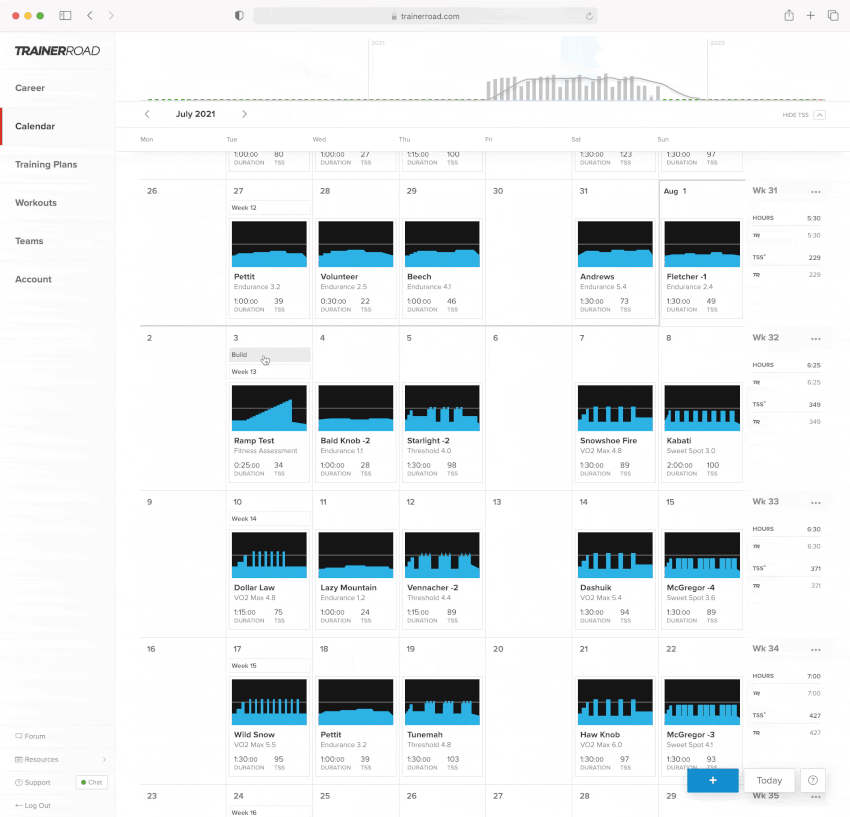Updated Training Plans: Why, How, and When To Update Your Plan

TrainerRoad is committed to constantly improving our training plans to make you a faster cyclist. We’ve used the data and insights from Adaptive Training and our machine learning algorithms to quantify workout difficulty more precisely than ever before. Every training plan still accomplishes the same objectives but has been optimized to increase its effectiveness.
Find out more on Workout Levels and the updated training plans, check out Ask A Cycling Coach Ep. 308.
Why Should I Follow the New Plans?
Our goal was to use the data we’ve gleaned from workout completion and ramp rates to optimize the progression of each training zones for every plan. This process involved adjusting the beginning and ending Workout Levels of each plan to develop the unique fitness related to your specific goals while increasing your odds of sustainable performance improvements.
If you want a more optimized and data-driven approach to reaching your goals, you should follow the new plans. That said, the previous plans are effective, but the new ones will increase your chances of success in reaching your goals.
What are Workout Levels?
Workout levels are a new metric in TrainerRoad that compares the relative difficulty of workouts within each training zone. Workout Levels go beyond Training Stress Score (TSS) and Intensity Factor (IF). Using Adaptive Training’s data-driven insights, they include more nuanced factors such as repetition, interval length, and recovery time.
Workout Levels give a more revealing insight because they’re based on individual training zones. The previous plan progressively ramped according to TSS, and while effective, Workout Levels allowed for a new level of optimization. For an in-depth look at Workout Levels, check out: Introducing Workout Levels: A New Way to Understand A Workout’s Difficulty
Why Do The Updated Plans Seem Different?
In the spirit of constant improvement, our goal with these plans was to make them even more effective at making you a faster cyclist, not to make them easier or harder. There is a temptation to assume that more arduous training will always yield better results, but our data shows that high-quality training yields better results. And high-quality training is consistent and progressive.
The starting Workout Levels, ramp rates, ending Workout Levels, rest weeks, and tapers of these plans are designed to put you in the best position to improve your performance as an athlete.
Why is there a difference in TSS?
Using TSS as the primary guiding metric in training plan construction can lead to a non-progressive ramp rate through each training zone affecting how each energy system is trained. Commonly, a plan that seems like it ramps consistently in TSS can be far from a consistent ramp according to how it trains your energy systems. This causes non-productive lulls in training productivity and excessively difficult workouts—all of which can halt your training progression.
In short, TSS is a vague metric that doesn’t consider the unique demands of different types of training. To make you a faster cyclist, we focus on training the energy systems, and their correlated training zones, that matter most to your goals. Using Workout Levels to build plans guarantees sustainable and productive ramp rates that are uniquely adjusted for each energy system and the plan’s goals.
Why do the plans progress differently?
Based on our data, anything within a 0.3-0.7 weekly progression in Workout Levels for a given Zone is considered achievable, productive, and sustainable. This doesn’t mean you couldn’t experience a 1, 2, or even 3 level increase in Workout Level from one week to the next. However, as the Workout Level increases get more significant, and when they are being accomplished in parallel with other high-intensity training zones, they become less likely to lead to productive and sustainable gains over time. The new progressions were designed to yield optimal performance gains.
When and How to Update Your Plan?
Updating your plan can seem daunting at first, and we want to ensure that you are making the most of your hard work. Below, you’ll find our recommendations for updating your training calendar to the new plans based on where you are in the season.
I haven’t started my plan, what should I do?
If you haven’t started your plan yet, we recommend that you switch to the new plans. You can simply delete the plan currently on your calendar and replace it with the new one. If you used Plan Builder, the easiest way to go to your calendar on TrainerRoad.com. Click the calendar annotation with the name of your first training block, then click “Update Plan”.

I’m in the middle of a plan; what should I do?
If you’re in the middle of a plan, we recommend updating your plan. Every Base, Build, and Speciality plan has been optimized, including the rest weeks and tapers. You can wait until you finish your current block and update the plan just before your next Ramp Test.
If you switch to the updated plans in the middle of a block, you may notice a decrease or increase in Workout Levels compared to what you have been doing. If this is the case, our recommendation is to substitute the workouts that remain in your current training block for workouts with Workout Levels within .5 of what you have been doing recently. This will ensure that you’ll still progress within your current training block.
Once you finish your current training block, you’ll start with a Ramp Test with the newly updated plans, and the workouts will once again be calibrated to your fitness.
What if I don’t want to update my plan?
You don’t have to change your current training block and can finish your current plan. Just remember that any recalculation in Plan Builder (like editing the dates of an A or B event) will update you to the new plan. That said, we do recommend using the updated plans as soon as you’re able.
How to select better workouts
There are more than 3,000 workouts to choose from within TrainerRoad. So even if you have a duration and training zone in mind, it can still be a daunting task to pick one suited to your abilities. Don’t worry, with Workout Levels and TrainNow; it has never been easier.
Workout Levels
Workout Levels help you choose workouts based on difficulty. We’ve added a new Level filter in the workout menu, to help you narrow down your search to workouts within a desired range. And within the Workouts menu, workouts are now organized in order of Workout Level by default, so you see an easiest to hardest range no matter what other filters you’ve applied. This way, even if your options include workouts of similar durations and interval structures, it’s easy to compare their relative difficulty and decide which one suits you best.
TrainNow
TrainNow automatically suggests workouts based on your current fitness level. It uses Adaptive Training’s machine learning-based insights to recommend workouts perfectly suited to your unique fitness. It also narrows the choice into three simple categories—Endurance for low-intensity aerobic conditioning, Climbing for more challenging sustained power efforts, and Attacking for high-intensity workouts. Each of these recommended workouts displays the Workout Level that’s right for you.